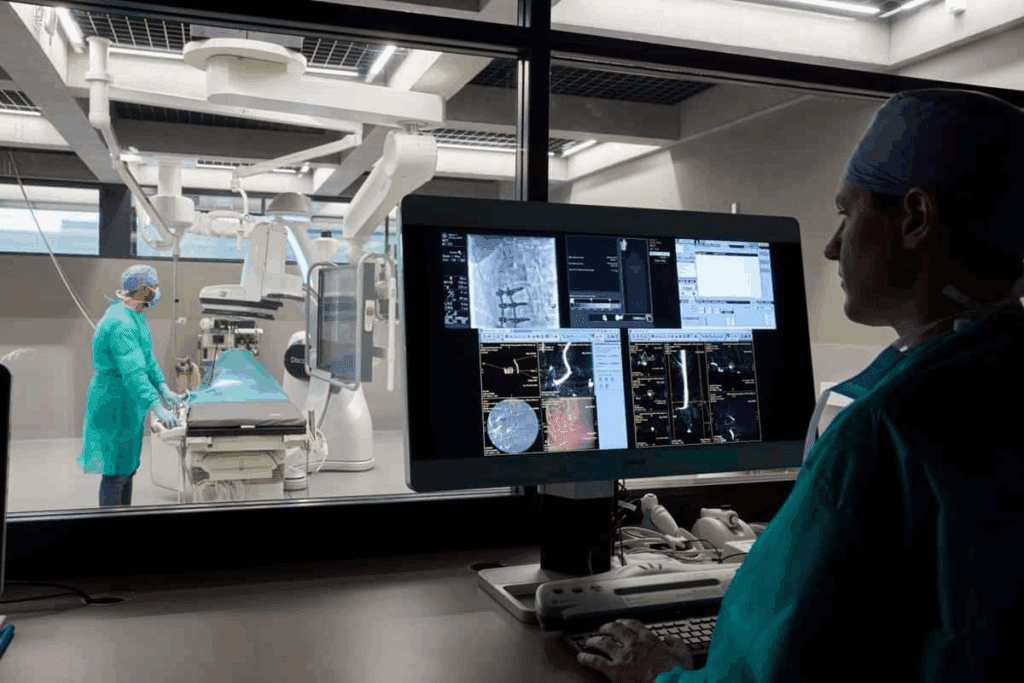Last Updated on November 26, 2025 by Bilal Hasdemir

Starting a career as a vascular interventional radiology tech needs technical skills, medical knowledge, and caring. We’ll show you how to join this cutting-edge field.
Interventional radiology is a fast-growing area. It uses small, precise procedures to find and treat blood vessel problems. Technologists in this field help doctors by running diagnostic tools and assisting in these detailed operations.
To do well in this job, you need special training and a certification. We’ll walk you through the steps. This includes what education you need, the clinical experience required, and the certification tests you’ll take. This will help you on your career journey.
Key Takeaways
- Understand the role of an interventional radiology technologist in vascular procedures.
- Learn the educational requirements for becoming an interventional radiology tech.
- Discover the importance of clinical experience in this field.
- Find out about the certification exams required for interventional radiology technologists.
- Explore the skills necessary to excel as an interventional radiology technologist.
Understanding Vascular Interventional Radiology

Vascular interventional radiology is a medical field that uses new technology and small procedures to help patients. We use images to guide tools inside the body. This helps us find and treat blood vessel problems accurately.
Definition and Minimally Invasive Procedures
Vascular interventional radiology uses images to guide small procedures. These minimally invasive procedures have small cuts. This means less damage to tissues and quicker healing.
The main points of these procedures are:
- Use of imaging technologies such as fluoroscopy and ultrasound
- Minimally invasive access to vascular structures
- Precision in diagnosing and treating vascular conditions
Benefits Over Traditional Surgical Approaches
Vascular interventional radiology has big advantages over old surgery methods. These include:
- Reduced recovery time: Patients can get back to their daily life faster.
- Less pain: These small procedures cause less pain because they don’t hurt as much tissue.
- Fewer complications: There’s a lower chance of problems compared to big surgeries.
By using these benefits, vascular interventional radiology is a great choice. It improves patient care and results.
The Role of an Interventional Radiology Technologist

Interventional radiology technologists are key in healthcare. They use diagnostic tools and help doctors with procedures. They make sure everything runs smoothly and equipment works right.
We’ll look at what they do every day. This includes setting up for procedures, keeping things clean, and helping doctors. Their job is important for patient care.
Daily Responsibilities and Clinical Duties
These technologists do many things each day. Here are some:
- They use tools like fluoroscopy and ultrasound.
- They help doctors with procedures.
- They get patients ready by explaining what will happen and making them comfortable.
- They keep everything clean to avoid infections.
- They watch over patients’ health during treatments.
They need to be very skilled and handle stress well. The American Society of Radiologic Technologists says they must talk well with patients and other doctors.
“The role of the radiologic technologist is critical in the diagnosis and treatment of patients. They must be knowledgeable about the equipment, procedures, and patient care.”
— American Society of Radiologic Technologists
Working Environment and Team Dynamics
They work in hospitals, clinics, and private offices. They’re part of a team with doctors, nurses, and others.
Their job can be very busy, like in emergencies. They must stay calm and focused, even when it’s tough.
| Work Environment | Key Characteristics |
| Hospitals | Fast-paced, high-pressure, varied cases |
| Clinics | Less emergent, more routine procedures |
| Private Practices | Varied, potentially less emergent than hospitals |
In summary, interventional radiology technologists are vital in healthcare. They need technical skills, attention to detail, and can handle stress. Their work is key to successful procedures and patient care.
Step 1: Complete Required Education
To start a career as a Vascular Interventional Radiology Tech, you need a solid educational base. First, you must know what education is needed and how to get it.
High School Preparation and Prerequisites
High school students aiming for this career should focus on science and math. Key subjects include biology, physics, and mathematics. These subjects are essential for future studies in radiologic technology. Also, learning health or medical terminology is helpful.
When applying to radiologic technology programs, colleges look for certain prerequisites. These include:
- Anatomy and Physiology
- Mathematics
- Physics or Chemistry
- Computer Skills
Associate or Bachelor’s Degree in Radiologic Technology
Most start with an associate or bachelor’s degree in radiologic technology from an accredited program. An associate degree takes two years and is a common entry point. A bachelor’s degree, which takes four years, may offer more advanced studies and career flexibility.
These programs combine classroom learning and clinical training. They cover topics like:
- Radiation safety and protection
- Radiographic positioning and procedures
- Patient care and assessment
- Radiologic technology equipment operation
Accredited Program Selection Criteria
Choosing a radiologic technology program requires checking for accreditation by a recognized agency, like the Joint Review Committee on Education in Radiologic Technology (JRCERT). Accreditation means the program meets standards and graduates can take certification exams.
Other important factors include:
- Curriculum and course structure
- Clinical experience opportunities
- Faculty qualifications and expertise
- Graduation and job placement rates
By picking an accredited program and completing your education, you set a strong foundation for your career.
Step 2: Obtain General Radiologic Technology Certification
Getting certified in general radiologic technology is a big step for those wanting to be vascular interventional radiology technologists. This certification is key after you finish your education in radiologic technology.
To get certified, you need to know what the American Registry of Radiologic Technologists (ARRT) requires. The ARRT is a top organization that certifies radiologic technologists. They make sure these professionals meet certain standards.
ARRT Primary Certification Requirements
The ARRT primary certification is a basic credential for radiologic technologists. To get this certification, you must:
- Finish an accredited program in radiologic technology.
- Pass the ARRT certification exam in radiography.
- Follow the ARRT’s Rules of Ethics, which cover professional conduct.
Passing the ARRT certification exam is a big deal. The exam checks your knowledge and skills in radiologic technology. It makes sure you’re ready to do the job.
State Licensing Procedures and Variations
Along with ARRT certification, many states need you to be licensed to work as a radiologic technologist. The rules for getting licensed vary a lot:
- Some states use the ARRT certification as a basis for licensure.
- Others may have their own licensing exams or extra requirements.
It’s important to check the specific requirements for the state where you want to work. Knowing these rules early can help you plan better. It ensures you follow state regulations.
By getting certified in general radiologic technology and following state licensing rules, you build a strong base for your career as a vascular interventional radiology technologist.
Step 3: Gain Clinical Experience as a Radiologic Technologist
Clinical experience is key for radiologic technologists. It gives us real-world skills. As we move towards becoming vascular interventional radiology techs, getting lots of clinical experience is a must.
Entry-Level Positions and Responsibilities
Most start in entry-level jobs in hospitals, imaging centers, or clinics. These jobs include using radiologic equipment, setting up patients for scans, and keeping patient records. Good communication and patient care skills are very important here.
At the start, we work under more experienced people. We learn about different imaging like X-ray, CT, and MRI. We also learn to keep patients and staff safe from too much radiation.
Building Core Competencies and Technical Skills
As we gain experience, we develop key skills for vascular interventional radiology. We learn to use complex equipment, understand imaging methods, and spot image quality issues. We also get better at working under pressure, managing time, and teaming up with healthcare teams.
Here’s a table showing how our skills grow:
| Competency | Entry-Level | Intermediate | Advanced |
| Operating Imaging Equipment | Familiarity with basic operation | Proficiency in standard procedures | Expertise in complex imaging techniques |
| Patient Positioning | Basic patient positioning | Accurate positioning for various exams | Advanced positioning for specialized procedures |
| Image Quality Assessment | Basic understanding of image quality | Ability to assess and adjust image quality | Expertise in optimizing image quality for diagnostic purposes |
By focusing on these skills, we build a strong base for vascular interventional radiology. Our experience improves our technical skills and boosts our confidence and understanding of patient care.
Step 4: Pursue Specialized Vascular Interventional Radiology Training
Getting specialized training in vascular interventional radiology is a big step. It includes learning through structured education and gaining hands-on experience. This is key for radiologic technologists who want to become vascular interventional radiology techs.
Structured Education Requirements
Structured education is a key part of vascular interventional radiology training. Programs usually cover vascular anatomy, interventional radiology procedures, and patient care. These programs aim to give technologists the knowledge to help with complex procedures.
It’s important to choose an accredited program that teaches both theory and practice. These programs often include lessons on radiation safety, contrast media, and angiographic imaging.
Clinical Procedure Requirements and Documentation
Clinical experience is a big part of vascular interventional radiology training. Trainees must take part in various clinical procedures with experienced professionals watching over them. This hands-on learning is essential for success.
Keeping records of clinical procedures is also important. Trainees need to document the procedures they help with, including the types of procedures, patient outcomes, and any complications. This documentation is vital for training and certification.
By combining structured education with real-world experience, aspiring vascular interventional radiology techs can become experts in their field.
Step 5: Prepare for and Pass the RT(VI) Certification Exam
Getting ready for the RT(VI) certification exam is key to becoming a certified vascular interventional radiology technologist. The exam, given by the American Registry of Radiologic Technologists (ARRT), checks your knowledge and skills in vascular interventional radiography.
ARRT Vascular Interventional Radiography Content Specifications
The ARRT Vascular Interventional Radiography certification exam covers many topics about vascular interventional procedures. The content includes:
- Patient preparation and care
- Equipment operation and quality control
- Image production and evaluation
- Radiation safety and protection
- Anatomy, physiology, and pathology related to vascular interventional procedures
Knowing these content specifications is key to focus your study efforts well. We recommend checking the ARRT’s detailed content outline for thorough preparation.
Effective Study Strategies and Resources
To get ready for the RT(VI) certification exam, use a multi-faceted study approach. Start by creating a study plan that outlines your goals and timelines. Use a variety of study materials, including:
- Textbooks and study guides specific to vascular interventional radiography
- Online courses and review programs
- Practice exams and quizzes to assess your knowledge
Joining a study group or participating in online forums can also help. It allows you to work with peers and get insights from others who are also preparing for the exam.
Also, use resources from the ARRT, like their official study guide and sample questions. This will help you get used to the exam format and content.
Essential Skills for Success in Vascular Interventional Radiology
Success in vascular interventional radiology needs a mix of skills. These skills include technical know-how and the ability to care for patients. Both are essential for a technologist’s job.
Technical and Procedural Competencies
Technical skills are the base for an interventional radiology technologist. They include:
- Knowing how to use complex imaging tools, like angiography systems.
- Understanding how to manage radiation safely.
- Helping with various procedures, like angiography and vascular stenting.
- Following strict infection control rules.
These skills grow from education, training, and real-world experience. Keeping up with new imaging tech is key. For example, fusion imaging and 3D mapping make procedures more precise.
Patient Care and Communication Abilities
Good patient care and communication are also critical. Technologists must:
- Give clear instructions and comfort to patients before, during, and after procedures.
- Watch patient vital signs and act quickly if needed.
- Work well with the healthcare team for smooth patient care.
- Keep patient records accurate and private.
Being empathetic and clear in communication helps reduce patient stress. This makes the experience better for everyone. By combining technical skills with caring, technologists are vital to vascular intervention success.
Maintaining Certification and Continuing Education
Keeping certification up to date is key for vascular interventional radiology technologists. Medical tech and procedures change often. So, they need to keep learning to give the best care to patients.
ARRT Renewal Requirements and CE Credits
The American Registry of Radiologic Technologists (ARRT) makes techs renew their certification. They must get CE credits in vascular interventional radiography. ARRT has rules for these credits, mixing category A and B.
Key aspects of ARRT renewal include:
- Completing the required number of CE credits within the specified timeframe
- Ensuring CE credits are relevant to vascular interventional radiography
- Maintaining accurate records of CE activities
Professional Development Opportunities
There are more ways to grow beyond just CE credits. Technologists can go to conferences, workshops, and online courses. These focus on new techniques and tech in interventional radiology.
Some benefits of professional development include:
- Staying current with advancements in vascular interventional radiology
- Networking with peers and industry experts
- Enhancing patient care through improved technical skills and knowledge
By keeping up with education and growth, technologists stay ahead. They give top-notch care to their patients.
Career Advancement and Specialization Pathways
Interventional radiology technology is always changing. To keep up, professionals need to look into different career paths. They can get advanced certifications, specialize in certain areas, or become leaders. This helps them grow in their careers and helps the field grow too.
Advanced Certifications and Specialties
Getting advanced certifications is key for career growth in interventional radiology. The American Registry of Radiologic Technologists (ARRT) has special certifications like Vascular Interventional Radiography. These can really help a technologist’s career.
Specializing in things like neurointervention, vascular interventions, or oncologic interventions can also lead to new chances.
Key areas for specialization include:
- Neurointervention
- Peripheral vascular interventions
- Oncologic interventions
By focusing on these areas, techs can become experts. This makes them more valuable to their employers and can lead to better jobs or roles.
Leadership Roles and Educational Opportunities
Interventional radiology techs can also grow by becoming leaders or pursuing education. Leadership roles might include supervising teams or managing departments. Educational roles could be teaching or developing curricula.
Leadership and education roles offer a change of pace and a chance to help others. They allow techs to mentor the next generation.
Also, staying updated through workshops, conferences, and online courses is important. It keeps techs current with new techniques and technologies. This makes them more competitive in the job market.
Conclusion
Becoming a vascular interventional radiology tech is a rewarding career. It needs dedication, education, and clinical experience. We’ve outlined the key steps to achieve this goal.
As an interventional radiology technologist, you play a vital role. You help deliver minimally invasive procedures that improve patient outcomes. It’s important to stay committed to ongoing education and professional development.
We offer career guidance and resources for those pursuing this career. By following the steps in this guide, you can start a fulfilling career. With the right training and expertise, you can excel as a vascular interventional radiology technologist.
FAQ
What is vascular interventional radiology?
Vascular interventional radiology is a medical field. It uses small procedures to treat blood vessel diseases. This approach leads to fewer complications, less pain, and quicker recovery times than traditional surgery.
What does an interventional radiology technologist do?
An interventional radiology technologist runs diagnostic tools. They help doctors during small procedures. They are key members of the healthcare team.
How do I become a vascular interventional radiology tech?
To become one, you need to finish your education and get certified. You also need to gain experience and pass a special exam.
What are the educational requirements for becoming an interventional radiology tech?
You need to finish high school and go to a radiologic technology program. This usually takes two years for an Associate’s degree or four for a Bachelor’s.
What is the importance of ARRT certification for interventional radiology techs?
ARRT certification shows you’re skilled. It’s often needed for jobs and state licenses.
How can I gain clinical experience as a radiologic technologist?
Start with entry-level jobs. Build your skills and knowledge. This is key for success in vascular interventional radiology.
What is the RT(VI) certification exam, and how do I prepare for it?
The RT(VI) exam is for vascular interventional radiology techs. Prepare by studying the ARRT Vascular Interventional Radiography content. Use good study strategies and resources.
What skills are required for success in vascular interventional radiology?
You need technical skills and the ability to care for patients. Good communication is also important.
How do I maintain my certification as a vascular interventional radiology tech?
Keep your certification by taking continuing education. Stay updated with professional news. Follow ARRT renewal rules.
What are the career advancement opportunities for interventional radiology techs?
You can get advanced certifications or specialties. You can also lead teams or pursue more education.
What is the role of continuing education in vascular interventional radiology?
Continuing education keeps you up-to-date. It ensures you can provide the best care to patients.
How can I specialize in vascular interventional radiology?
To specialize, get specialized training. Gain experience and get the RT(VI) certification.
References
Majumdar, A., et al. (2024). Current trends in herbal medicines targeting renal cell carcinoma. Phytomedicine, 131, 152837. https://www.sciencedirect.com/science/article/abs/pii/S2950199724001174






